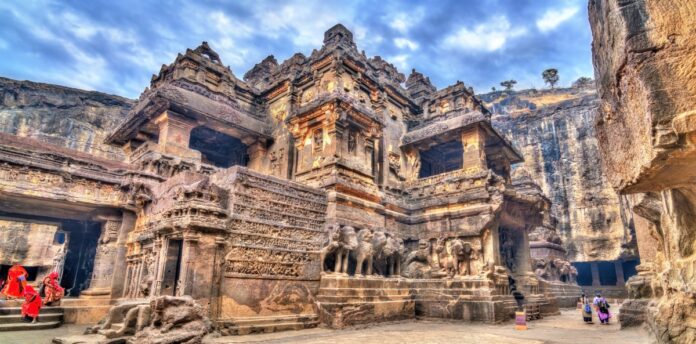Ajanta and Ellora Caves Complete Guide
Nestled within the rugged terrains of Maharashtra, India, lie the Ajanta and Ellora Caves—timeless marvels that transcend the boundaries of history, art, and spirituality. These cave complexes, designated as UNESCO World Heritage Sites, beckon travelers on a journey through the ages, revealing the rich tapestry of India’s cultural and religious evolution.
History of Ajanta and Ellora Caves
Nestled in the heart of Maharashtra, India, the Ajanta and Ellora Caves stand as timeless witnesses to the artistic and architectural brilliance of ancient civilizations. These cave complexes, designated as UNESCO World Heritage Sites, represent a rich tapestry of Indian history, spanning several centuries.
Ajanta Caves:
- Origins: The Ajanta Caves, dating back to the 2nd century BCE, were primarily a Buddhist monastic complex carved into the rocky hills of the Sahyadri Range. The caves are renowned for their exquisite murals and sculptures that depict the life and teachings of Buddha.
- Construction: The Ajanta Caves consist of 29 rock-cut caves that served as prayer halls, monasteries, and chaityas. The intricate carvings and vibrant frescoes reflect the influence of various dynasties, including the Satavahanas, Vakatakas, and the Chalukyas.
- Golden Age: The zenith of Ajanta’s artistic glory was during the Vakataka period in the 5th century CE. The artists adorned the cave walls with vivid paintings portraying scenes from Jataka tales and the life of Buddha.
Also Read: Places to Visit Near Shirdi Within 100 km
Ellora Caves:
- Diversity of Faiths: Ellora, in contrast, is a testament to religious harmony, as it houses caves dedicated to Buddhism, Hinduism, and Jainism. The construction of Ellora Caves spans a broad timeline from the 6th to 10th centuries CE.
- Kailasa Temple: The centerpiece of Ellora is undoubtedly the Kailasa Temple, a colossal monolithic structure carved from a single rock. This marvel is dedicated to Lord Shiva and showcases intricate carvings and sculptures depicting Hindu mythology.
- Jain Caves: Ellora’s Jain caves, numbering 32 to 34, are celebrated for their detailed depictions of Jain philosophy. The intricately carved columns and sculptures narrate the lives of Jain Tirthankaras.
Ajanta and Ellora Caves Location
Ajanta Caves Location:
- Geographical Setting: The Ajanta Caves are situated in the Aurangabad district of Maharashtra, India, within the folds of the Sahyadri Range. The complex is perched along the Waghora River, creating a serene and picturesque backdrop.
- Accessibility: Ajanta is approximately 100 kilometers from Aurangabad, the nearest major city. The caves are well-connected by road, and visitors can hire local transportation or use their own vehicles to reach the site.
- Natural Beauty: The caves are strategically located in a horseshoe-shaped gorge, adding to the allure of the surroundings. The lush greenery and the rhythmic flow of the Waghora River create a tranquil atmosphere, enhancing the spiritual experience for visitors.
Ellora Caves Location:
- Proximity to Ajanta: Ellora is located about 30 kilometers from Ajanta, making it convenient for travelers to explore both cave complexes during a single visit.
- Aurangabad Connection: Similar to Ajanta, Ellora is easily accessible from Aurangabad. The city serves as a gateway to these ancient wonders, providing transportation options such as buses and taxis.
- Topography: Ellora is situated on the Deccan Plateau, surrounded by low hills. The landscape adds a unique dimension to the site, and the caves are strategically carved into the Charanandri Hills.
How to Reach Ajanta and Ellora Caves
By Air:
- Nearest Airport: The Aurangabad Airport serves as the closest air hub for those planning to visit Ajanta and Ellora Caves. Regular domestic flights connect Aurangabad to major cities like Mumbai, Delhi, and Jaipur.
- Travel Tips: Upon landing in Aurangabad, visitors can hire taxis or use local transportation to reach the caves. It’s advisable to check flight schedules and book tickets in advance, especially during peak tourist seasons.
By Train:
- Railway Connectivity: Aurangabad Railway Station is the primary railhead for travelers heading to Ajanta and Ellora. The station is well-connected to major cities in India, including Mumbai, Pune, and Delhi.
- Local Transportation: From Aurangabad Railway Station, visitors can hire taxis or use buses to reach the cave complexes. The road journey offers glimpses of the rural landscape and adds to the overall travel experience.
By Road:
- Road Networks: Ajanta and Ellora are well-connected by a network of roads. Buses run by MSRTC and private buses operate regular services from Aurangabad to the caves. Travelers can also hire private taxis or use their vehicles to reach the site.
- Scenic Drives: The road journey from Aurangabad to the caves is not only convenient but also scenic. The route passes through picturesque landscapes, providing travelers with a glimpse of rural life in Maharashtra.
Travel Tips:
- Entry Fees and Timings: Visitors should check the official website or local authorities for the latest information on entry fees and timings. It’s advisable to plan the visit during weekdays to avoid crowds.
- Guided Tours: To make the most of the experience, consider hiring a local guide who can provide insights into the history, architecture, and significance of each cave. Guides are often available at the entrance of the cave complexes.
- Weather Considerations: Maharashtra experiences diverse climatic conditions. While the caves are open throughout the year, it’s recommended to check the weather forecast and plan the visit accordingly.
In conclusion, the Ajanta and Ellora Caves are not just archaeological wonders but living testaments to the cultural and religious diversity that has shaped India over the centuries. Whether you are an art enthusiast, history buff, or a spiritual seeker, a journey to these cave complexes promises a profound and immersive experience. The fusion of natural beauty, ancient craftsmanship, and spiritual significance makes Ajanta and Ellora a must-visit destination for anyone seeking a deeper connection with India’s rich cultural heritage.
Ajanta and Ellora Caves are located in which state?
Ajanta and Ellora Caves are located in the state of Maharashtra, India.
Who built Ellora Caves?
Ellora Caves were built by various dynasties over several centuries. The construction work at Ellora spans from the 6th to the 10th centuries CE, and different caves were sponsored by different rulers. The Kailasa Temple, a magnificent monolithic structure at Ellora, was built during the Rashtrakuta dynasty rule and is attributed to King Krishna I.
Where is Ajanta and Ellora Caves?
Ajanta and Ellora Caves are located in the Aurangabad district of Maharashtra, India. Ajanta is approximately 100 kilometers from Aurangabad, and Ellora is about 30 kilometers from Ajanta. The caves are situated within the Sahyadri Range and are easily accessible from the city of Aurangabad.





